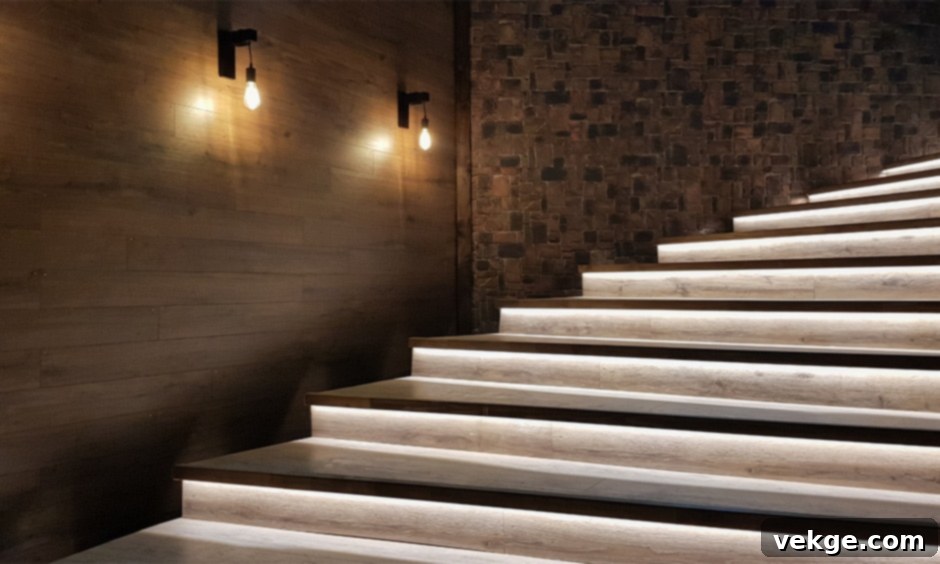Brilliant Staircase Lighting Ideas: Elevate Your Home’s Aesthetic and Safety
The staircase is far more than just a functional transition between floors; it’s often one of the first architectural features guests encounter upon entering a home. As such, proper lighting on and around your staircase is not merely a matter of practicality but a crucial element of interior design. Thoughtful illumination significantly improves safety by preventing trips and falls, but equally important, it dramatically enhances the aesthetic appeal, complementing your overall decor theme and creating a welcoming ambiance. Much like carefully selected art, attractive wall paint, or elegant furniture, effective staircase lighting acts as a powerful decorative element. Imagine hosting a gathering: your staircase, beautifully lit and maintained, naturally becomes a focal point, drawing admiration and contributing to the festive mood. Indeed, well-executed lighting and decor breathe life into a home, bringing immense satisfaction and joy to residents and visitors alike.
Achieving the perfect balance of form and function with your staircase lighting involves exploring a variety of options. From grand, statement-making chandeliers that command attention to subtle, integrated step lights that guide the way, there’s a world of creative possibilities. Below, we delve into ingenious ways to incorporate various lighting solutions into your staircase decor, ensuring both safety and unparalleled style.
1. Hang a Stunning Chandelier
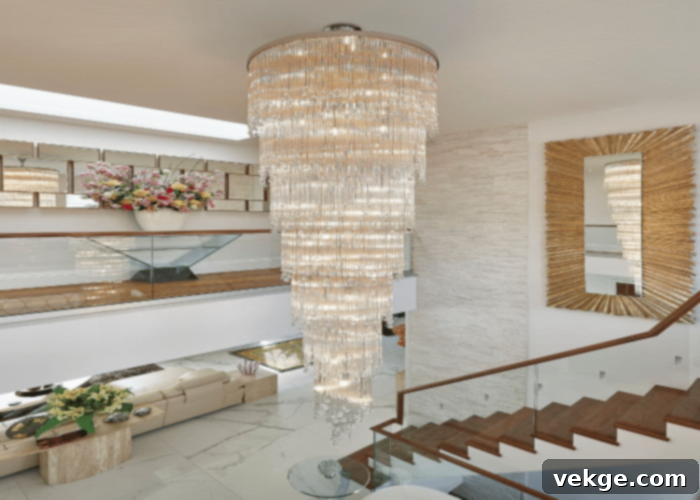
A magnificent chandelier remains an enduring classic for illuminating a staircase, instantly transforming the space into a grand statement. This type of fixture doesn’t just provide light; it serves as a central art piece, making a bold design declaration. When selecting a chandelier, ensure it harmonizes with your home’s existing aesthetic – perhaps a sleek, minimalist design for a modern interior, a wrought-iron piece for a farmhouse appeal, or a sparkling crystal fixture for a glamorous, traditional setting. The material, size, and style of the chandelier should complement the overall architecture and decor of your home.
For optimal effect, install the chandelier above the bottom landing, allowing it to cast an inviting ambient light across the initial steps and entryway. In homes with high or two-story ceilings, consider a multi-tiered fixture positioned above the top landing or centrally in the stairwell void to illuminate both levels comprehensively. Ensure that its placement and illumination complement, rather than overpower, other lighting designs or decorative elements in the vicinity. A dimmer switch is highly recommended to control the intensity, allowing you to create different moods, from bright and welcoming to soft and sophisticated.
2. Use Wall Sconces Liberally
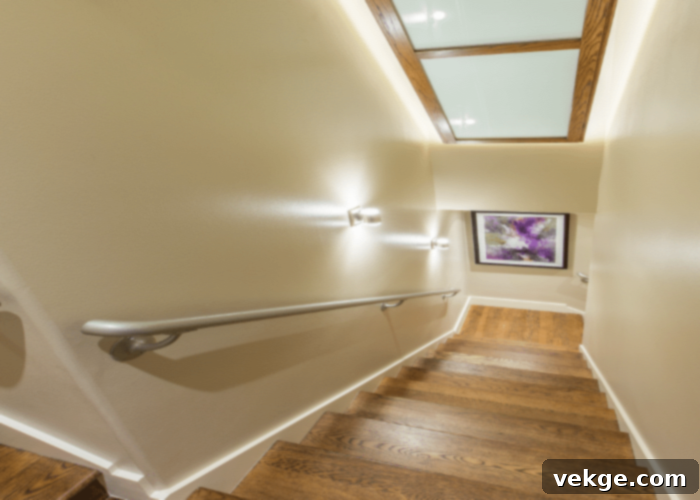
Wall sconces are an excellent choice for staircase lighting, offering directed, vertical illumination that is both functional and aesthetically pleasing. They effectively highlight the wall, add depth, and guide users safely up and down the steps. You can opt for custom-made sconces designed to perfectly match your staircase railing or architectural style, or choose from a vast array of compatible styles ranging from classic lantern designs to contemporary LED bars. Sconces with an up-lighting feature can create subtle, dramatic shadows, while those with down-lighting or shaded designs prevent harsh glare, ensuring comfortable visibility.
Position these fixtures along the wall, typically above the railing, ensuring they do not obstruct pathways or interfere with hand placement. The key is to place them frequently enough to eliminate any dimly lit spots, providing continuous, even light across the entire flight of stairs. Consider the height – generally, eye-level when ascending the stairs is ideal to prevent glare. Many modern sconces feature frosted glass or internal diffusers, which help soften the light, making the journey up or down more pleasant while effectively illuminating each step and the surrounding wall decor.
3. Install Recessed Step Lights

For subtle yet highly effective illumination, recessed lights built discreetly into stair risers are an outstanding solution. These provide even, focused lighting directly onto the steps, significantly enhancing safety without being obtrusive. Look for narrow, low-profile LED lights, which are energy-efficient and offer a long lifespan. These can be hardwired to turn on with a regular switch, or for ultimate convenience and energy saving, consider installing motion or dusk-to-dawn sensors. This ensures the lights activate automatically when needed, providing illumination only when someone approaches or when ambient light levels drop.
Strategically position these lights near the inside corners of the steps, or along the lower part of the riser, to ensure the light is not blocked by footsteps and effectively highlights the edge of each tread. While white light is most common, for an extra touch of allure and personality, some homeowners choose step lights with fun, subtle colors like soft blue or warm amber. These can even be set to transition between hues slowly, creating a dynamic and enchanting effect. The key is to avoid overly bright or glaring lights, which can detract from the ambiance and create a harsh, unwelcoming look. The goal is a gentle glow that clearly defines each step.
4. Accent with Rail Lighting
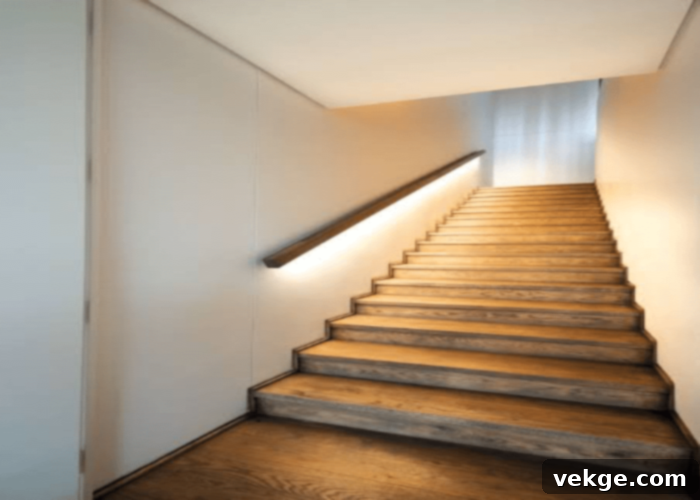
Using integrated LED lighting to accent staircase railings or glass panels creates a truly dramatic visual appeal and modern elegance. This approach allows the railing itself to become a source of soft, guiding light. You can outline the top and bottom edges of railings, newel posts, or even the balusters with slim, flexible LED strip lighting. For staircases featuring glass dividers, installing sleek light bars discreetly behind these panels can create a stunning, ethereal glow that highlights the transparency and modern design.
Explore various rail lighting options, such as uplighting to subtly emphasize the architectural details of the railing and wall above, or downlighting to directly illuminate the stairs below. Many contemporary LED systems come with advanced controls, enabling you to adjust colors, brightness, and even light patterns to suit different moods, occasions, or seasons. This not only adds a layer of sophistication but also significantly enhances safety by clearly defining the handrail and the path of travel.
5. Use Tread Lights
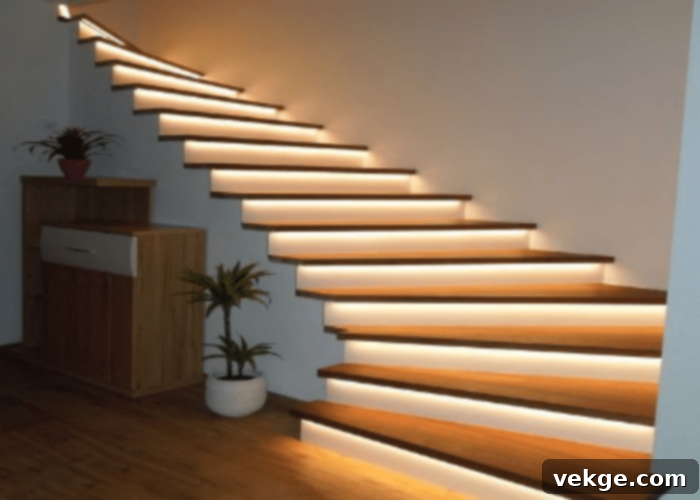
Under-stair lighting, often referred to as tread lights, involves recessed fixtures or LED strips integrated directly into the edge or underside of the stair treads themselves. This method provides functional and decorative illumination that is incredibly subtle yet highly effective in making navigating stairs safer, especially in low-light conditions. When implemented thoughtfully, these lights can create a striking, almost floating effect, especially on open-riser staircases, adding a contemporary and luxurious touch to your home’s interior.
For an even greater visual impact, consider installing LED light strips beneath transparent glass treads or along the support structures of metal treads and risers. Uplights precisely positioned along the underside edge of open-tread stairs can create a beautiful ambient glow that washes the wall behind, enhancing depth and architectural interest. It’s crucial to ensure that tread lights are evenly spaced and distributed to fully illuminate the entire width and length of the staircase, eliminating any dark spots and providing consistent visibility. This meticulous placement guarantees both safety and an elegant aesthetic.
6. Highlight with Decorative Fixtures
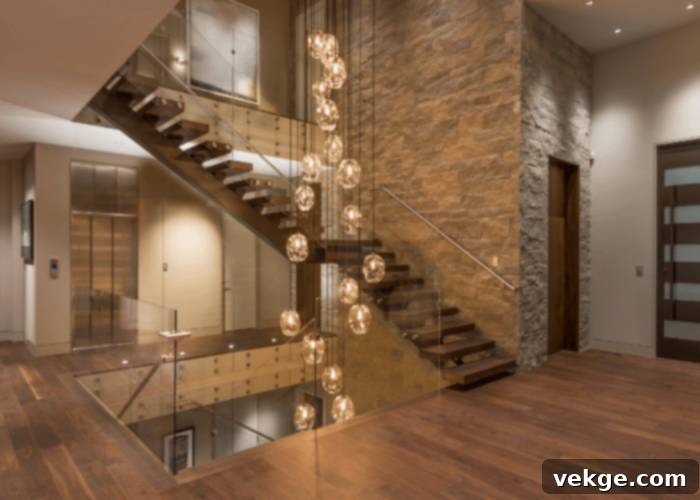
Beyond strictly functional lighting, incorporating creatively chosen decorative fixtures can infuse your staircase decor with significant drama and personality. Think about hanging a series of vintage pendant lights at varying heights over a stair landing to create a captivating visual cluster. Alternatively, install sleek, modern sconces on the wall above the landing or at key turns, chosen for their sculptural quality as much as their light output. A particularly elegant touch can be a smaller, exquisite chandelier positioned above a newel post at the base or top of the stairs, marking the beginning or end of the journey with a luminous accent.
When searching for these fixtures, look for elements with distinctive flair – perhaps crystalline drops that sparkle, tiered fabric shades that add texture, or clean metallic finishes that reflect light beautifully. The ultimate goal is for these decorative luminaires to seamlessly complement your existing design scheme while injecting a unique and personalized character into the staircase area. It’s important to choose fixtures whose scale and brightness do not overpower the staircase’s architecture or compete with other decorative elements, but rather enhance and unify the overall design.
7. Play with Uplighting and Silhouettes
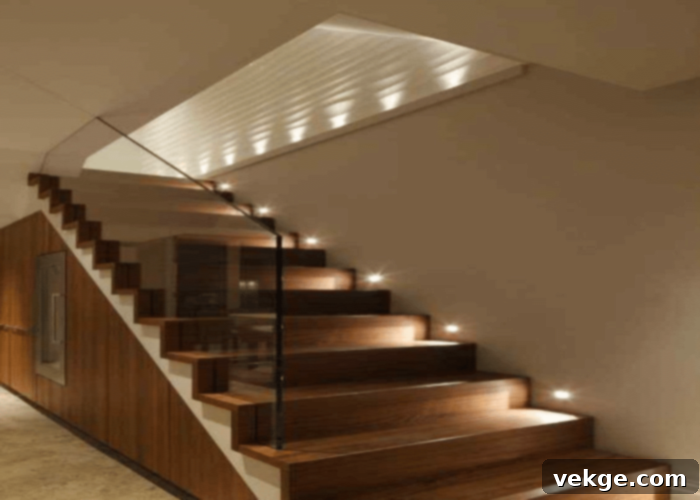
Uplighting, strategically placed to cast light upwards, can create truly intriguing visual effects and dramatic light play around your staircase. By illuminating walls or ceilings from below, you can artistically create captivating shadows and highlight the elegant outlines of railings, spindles, and architectural curves. This technique adds depth, texture, and a sense of theatricality to the space, making the staircase feel more expansive and thoughtfully designed.
Experiment with positioning uplights from various points: recessed into the floor above landings, hidden behind the base of railings, or integrated into cove ceilings surrounding the stairwell. These indirect light sources bathe the area in a soft, ambient glow rather than direct harsh light, contributing to a cozy and sophisticated atmosphere. Dimmer controls are absolutely essential for uplighting, allowing you to fine-tune the brightness and adjust the mood and ambiance for different times of day or specific occasions. For optimal visual impact and energy efficiency, consider adding timers to activate such uplighting only during evening hours, transforming your staircase into a truly enchanting feature after sunset.
8. Incorporate Natural Lighting

While artificial lighting offers incredible versatility, making the most of sunlight to naturally illuminate your staircase is both energy-efficient and creates an unparalleled sense of warmth and openness. Large windows positioned at the ends of stairways, especially floor-to-ceiling designs, allow an abundance of natural light to flood the entire stairwell. Similarly, skylights or clerestory windows installed overhead can effectively brighten upstairs landings and the upper sections of the staircase throughout the day, reducing the need for artificial light.
To maximize this natural resource, consider removing heavy draperies or blinds that might block light. Opt for sheer curtains or minimalist window treatments if privacy is a concern. If direct natural sunlight is limited due to the home’s orientation or structural constraints, strategically placed mirrors can be incredibly effective. Mirrors amplify and reflect existing light, making the space feel larger and brighter. However, it’s crucial to pay close attention to sightlines and the angle of reflection to avoid creating uncomfortable glare that shines directly into people’s eyes as they ascend and descend the stairs. A well-designed interplay of natural and artificial light creates a dynamic and inviting staircase throughout all hours.
9. Smart Technology for Convenience
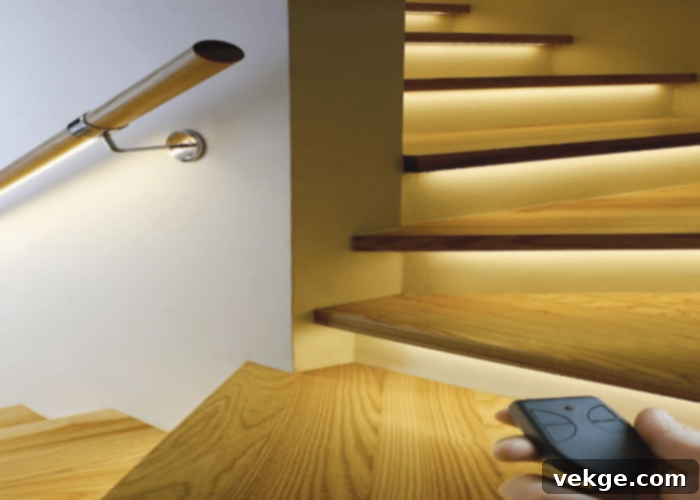
In today’s technologically advanced world, smart lighting solutions offer the ultimate convenience and precise control over your staircase illumination. Integrating fixtures with dimmer switches or, even better, WiFi-enabled smart home systems allows for effortless management. You can control brightness levels, color temperatures, and even schedule lighting scenes directly from wall panels, remote controls, or the convenience of your smartphone or voice assistant. This level of control allows you to tailor the ambiance for any occasion, from a brightly lit functional space to a softly glowing, romantic pathway.
Further enhancing automation and safety, motion sensor switches can be installed to automatically activate lights when someone enters the stairwell or approaches the steps, eliminating the need to fumble for switches in the dark. You can also program stair lights to turn on gradually at dusk, providing a seamless transition from daylight to artificial illumination as natural light fades. Some advanced systems even allow for “pathway” lighting, where a sequence of lights turns on as you move up or down the stairs. Such intelligent features make staircase lighting not only more automated and hassle-free but also contribute significantly to energy savings and overall home security, making your daily life simpler and safer.
Conclusion
With careful planning, strategic placement, and an understanding of the various options available, the right lighting can truly transform your staircase from a simple architectural element into a stunning design feature. It’s about much more than just visibility; it’s about creating an atmosphere, enhancing safety, and elevating your home’s overall decor. Whether you choose to accentuate intricate architectural details, incorporate unique decorative fixtures, harness the beauty of natural light, or integrate smart home technology, each choice contributes to a holistic design. Your well-illuminated staircase will not only be highly functional and safe for everyone but will also stand out as a beautiful, captivating focal point that leaves a lasting impression.
Indeed, when you have a staircase that is meticulously designed, exquisitely decorated, and perfectly lit, your house has the potential to become the talk of the town, etched into the minds of all who visit. The warm, inviting, and sophisticated ambiance that thoughtful lighting creates can dramatically upgrade the beauty, elegance, and glamor of your entire home. By following these essential tips on how to effectively incorporate lighting into your staircase design, you can achieve a truly spectacular transformation, enhancing both the practicality and the aesthetic appeal of this central feature.
